Investigation of Tropical Cyclones in the North Indian Ocean and the Linkage to Extreme Weather Events over Sri Lanka
Abstract
1. Introduction
2. Materials and Methods
3. Results
3.1. TCs in the Pre-Monsoon Period
Effect of IOD on TC over the Pre-Monsoon Season
3.2. TCs in the Post-Monsoon Period
Effect of IOD on TC over the Post-Monsoon Season
4. Discussion
5. Conclusions
- Strong westerly winds at sea level extending from the Southern Hemispheric Somali jet wind (from the vast ocean area) were the continuous moisture supplier to the BoB region. As a result, the BoB area exhibited high WV content.
- The airflow with high WV content came mainly from the SH, and this background WV flow connected with the LPS which contributed to the rapid development of the system. These cyclones followed a northward track with wind flowing across Sri Lanka in a southwesterly to southerly direction. As a result, heavy rainfall and extensive damage occurred in the southwestern part of the country.
- In negative IOD years, cyclonic circulations form on either side of the equator and develop rapidly.
- There is a strong correlation between the IOD index and maximum rainfall. In negative IOD years or neutral IOD years, high WV concentration in the EIO region supports the continuous moisture supply for the system, resulting in a significant amount of high rainfall over Sri Lanka.
- Most TCs followed a westward track and were likely to make landfall in Sri Lanka.
- Supportive winds and the WV for the LPS came from NH (from the continental area), and the LPS was isolated from the background WV flow. High damage was recorded in the Eastern, Northern, and Northcentral provinces during this period.
- There is a weak correlation between the IOD phase and the maximum rainfall. The cyclone system is not significantly affected by the IOD phase that leads to heavy rain over Sri Lanka.
Author Contributions
Funding
Institutional Review Board Statement
Informed Consent Statement
Data Availability Statement
Acknowledgments
Conflicts of Interest
Abbreviations
| TC | Tropical cyclone |
| NIO | North Indian Ocean |
| IOD | Indian Ocean Diploe |
| WV | Water vapor |
| EIO | Equatorial Indian Ocean |
| IO | Indian Ocean |
| LPS | Low-pressure system |
| BoB | Bay of Bengal |
| NH | Northern Hemisphere |
| SH | Southern Hemisphere |
| JRA55 | Japanese 55-Year Reanalysis |
| JTWC | Joint Typhoon Warning Center |
| IVT | Vertically integrated water vapor transport |
| UTC | Coordinated Universal Time |
| ITCZ | Inter-Tropical Convergence Zone |
References
- Jayawardena, I.M.S.P.; Darshika, D.W.T.T.; Herath, H.M.R.C. Recent Trends in Climate Extreme Indices over Sri Lanka. Am. J. Clim. Chang. 2018, 7, 586–599. [Google Scholar] [CrossRef]
- Srisangeerthanan, S.; Lewangamage, C.; Wickramasuriya, S.S. Tropical Cyclone Damages in Sri Lanka. Wind Eng. JAWE 2015, 40, 294–302. [Google Scholar] [CrossRef]
- Crisis Report—Sri Lanka Flood Update 22 May 2003—Sri Lanka|ReliefWeb. Available online: https://reliefweb.int/report/sri-lanka/crisis-report-sri-lanka-flood-update-22-may-2003 (accessed on 5 February 2024).
- Koralegedara, S.B.; Lin, C.-Y.; Sheng, Y.-F. Numerical Analysis of the Mesoscale Dynamics of an Extreme Rainfall and Flood Event in Sri Lanka in May 2016. J. Meteorol. Soc. Jpn. Ser II 2019, 97, 821–839. [Google Scholar] [CrossRef]
- Mahala, B.K.; Nayak, B.K.; Mohanty, P.K. Impacts of ENSO and IOD on Tropical Cyclone Activity in the Bay of Bengal. Nat. Hazards 2015, 75, 1105–1125. [Google Scholar] [CrossRef]
- Camargo, S.J.; Wheeler, M.C.; Sobel, A.H. Diagnosis of the MJO Modulation of Tropical Cyclogenesis Using an Empirical Index. J. Atmos. Sci. 2009, 66, 3061–3074. [Google Scholar] [CrossRef]
- Yanase, W.; Satoh, M.; Taniguchi, H.; Fujinami, H. Seasonal and Intraseasonal Modulation of Tropical Cyclogenesis Environment over the Bay of Bengal during the Extended Summer Monsoon. J. Clim. 2012, 25, 2914–2930. [Google Scholar] [CrossRef]
- Li, Z.; Li, T.; Yu, W.; Li, K.; Liu, Y. What Controls the Interannual Variation of Tropical Cyclone Genesis Frequency over Bay of Bengal in the Post-monsoon Peak Season? Atmos. Sci. Lett. 2016, 17, 148–154. [Google Scholar] [CrossRef]
- Li, Y.; Qian, C.; Fan, X.; Liu, B.; Ye, W.; Lin, J. Impact of Tropical Cyclones over the North Indian Ocean on Weather in China and Related Forecasting Techniques: A Review of Progress. J. Meteorol. Res. 2023, 37, 192–207. [Google Scholar] [CrossRef]
- George, B.; Kutty, G. Sensitivity Analysis Applied to Two Extreme Rainfall Events over Kerala Using TIGGE Ensembles. Meteorol. Atmos. Phys. 2022, 134, 22. [Google Scholar] [CrossRef]
- Viswanadhapalli, Y.; Srinivas, C.V.; Basha, G.; Dasari, H.P.; Langodan, S.; Venkat Ratnam, M.; Hoteit, I. A Diagnostic Study of Extreme Precipitation over Kerala during August 2018. Atmos. Sci. Lett. 2019, 20, e941. [Google Scholar] [CrossRef]
- Vijaykumar, P.; Abhilash, S.; Sreenath, A.V.; Athira, U.N.; Mohanakumar, K.; Mapes, B.E.; Chakrapani, B.; Sahai, A.K.; Niyas, T.N.; Sreejith, O.P. Kerala Floods in Consecutive Years—Its Association with Mesoscale Cloudburst and Structural Changes in Monsoon Clouds over the West Coast of India. Weather Clim. Extrem. 2021, 33, 100339. [Google Scholar] [CrossRef]
- Mohandas, S.; Francis, T.; Singh, V.; Jayakumar, A.; George, J.P.; Sandeep, A.; Xavier, P.; Rajagopal, E.N. NWP Perspective of the Extreme Precipitation and Flood Event in Kerala (India) during August 2018. Dyn. Atmos. Oceans 2020, 91, 101158. [Google Scholar] [CrossRef]
- Xiao-ting, F.; Ying, L.; Ai-min, L.; Long-sheng, L. Statistical and Comparative Analysis of Tropical Cyclone Activity over the Arabian Sea and Bay of Bengal (1977–2018). J. Trop. Meteorol. 2020, 26, 441–452. [Google Scholar] [CrossRef]
- Bhardwaj, P.; Singh, O. Climatological Characteristics of Bay of Bengal Tropical Cyclones: 1972–2017. Theor. Appl. Climatol. 2020, 139, 615–629. [Google Scholar] [CrossRef]
- Saji, N.H.; Goswami, B.N.; Vinayachandran, P.N.; Yamagata, T. A Dipole Mode in the Tropical Indian Ocean. Nature 1999, 401, 360–363. [Google Scholar] [CrossRef] [PubMed]
- Ueda, H. Equatorial Monsoon System as Regulation for a Dipole Mode in the Indian Ocean. Pap. Meteorol. Geophys. 2001, 51, 147–154. [Google Scholar] [CrossRef][Green Version]
- Yuan, J.; Cao, J. North Indian Ocean Tropical Cyclone Activities Influenced by the Indian Ocean Dipole Mode. Sci. China Earth Sci. 2013, 56, 855–865. [Google Scholar] [CrossRef]
- Behera, S.K.; Doi, T.; Ratnam, J.V. 5—Air–Sea Interactions in Tropical Indian Ocean: The Indian Ocean Dipole. In Tropical and Extratropical Air-Sea Interactions; Behera, S.K., Ed.; Elsevier: Amsterdam, The Netherlands, 2021; pp. 115–139. ISBN 978-0-12-818156-0. [Google Scholar]
- Congwen, Z.; Nakazawa, T.; Jianping, L. Modulation of Twin Tropical Cyclogenesis by the MJO Westerly Wind Burst during the Onset Period of 1997/98 ENSO. Adv. Atmos. Sci. 2003, 20, 882–898. [Google Scholar] [CrossRef]
- Situation Reports. Available online: https://www.dmc.gov.lk/index.php?option=com_dmcreports&view=reports&report_type_id=1&Itemid=273&lang=en (accessed on 5 February 2024).
- Kobayashi, S.; Ota, Y.; Harada, Y.; Ebita, A.; Moriya, M.; Onoda, H.; Onogi, K.; Kamahori, H.; Kobayashi, C.; Endo, H.; et al. The JRA-55 Reanalysis: General Specifications and Basic Characteristics. J. Meteorol. Soc. Jpn. Ser. II 2015, 93, 5–48. [Google Scholar] [CrossRef]
- JRA-55_handbok_TL319_en.Pdf. Available online: https://jra.kishou.go.jp/JRA-55/document/JRA-55_handbook_TL319_en.pdf (accessed on 25 February 2024).
- Japan Meteorological Agency/Japan JRA-55: Japanese 55-Year Reanalysis, Daily 3-Hourly and 6-Hourly Data 2013, 86.806 Tbytes. Available online: https://rda.ucar.edu/datasets/ds628.0/ (accessed on 25 February 2024).
- Chu, J.-H.; Sampson, C.R.; Levine, A.S.; Fukada, E. The Joint Typhoon Warning Center Tropical Cyclone Best-Tracks, 1945–2000. Ref NRLMR7540-02-16. Available online: http://www.usno.navy.mil/NOOC/nmfc-ph/RSS/jtwc/best_tracks/TC_bt_report.html (accessed on 12 December 2022).
- Joint Typhoon Warning Center (JTWC). Available online: https://www.metoc.navy.mil/jtwc/jtwc.html?north-indian-ocean (accessed on 25 February 2024).
- Miao, H.; Dong, D.; Huang, G.; Hu, K.; Tian, Q.; Gong, Y. Evaluation of Northern Hemisphere Surface Wind Speed and Wind Power Density in Multiple Reanalysis Datasets. Energy 2020, 200, 117382. [Google Scholar] [CrossRef]
- Das, A.; Baidya Roy, S. JRA55 Is the Best Reanalysis Representing Observed Near-Surface Wind Speeds over India. Atmos. Res. 2024, 297, 107111. [Google Scholar] [CrossRef]
- Historical ENSO Events. Available online: https://ds.data.jma.go.jp/tcc/tcc/products/elnino/iodevents.html (accessed on 10 April 2023).
- Indian Ocean Dipole (IOD) Index Vital Signs. Available online: https://sealevel.jpl.nasa.gov/data/vital-signs/indian-ocean-dipole (accessed on 25 February 2024).
- Ranasinghe, E.M.S. Meteorological Setting of Sri Lanka. Available online: http://archive.cmb.ac.lk:8080/research/bitstream/70130/3804/1/emsr.pdf (accessed on 5 September 2023).
- Uddin, M.J.; Li, Y.; Cheung, K.K.; Nasrin, Z.M.; Wang, H.; Wang, L.; Gao, Z. Rainfall Contribution of Tropical Cyclones in the Bay of Bengal between 1998 and 2016 Using TRMM Satellite Data. Atmosphere 2019, 10, 699. [Google Scholar] [CrossRef]
- DIAS Dataset Search and Discovery. Available online: https://search.diasjp.net/en (accessed on 25 February 2024).
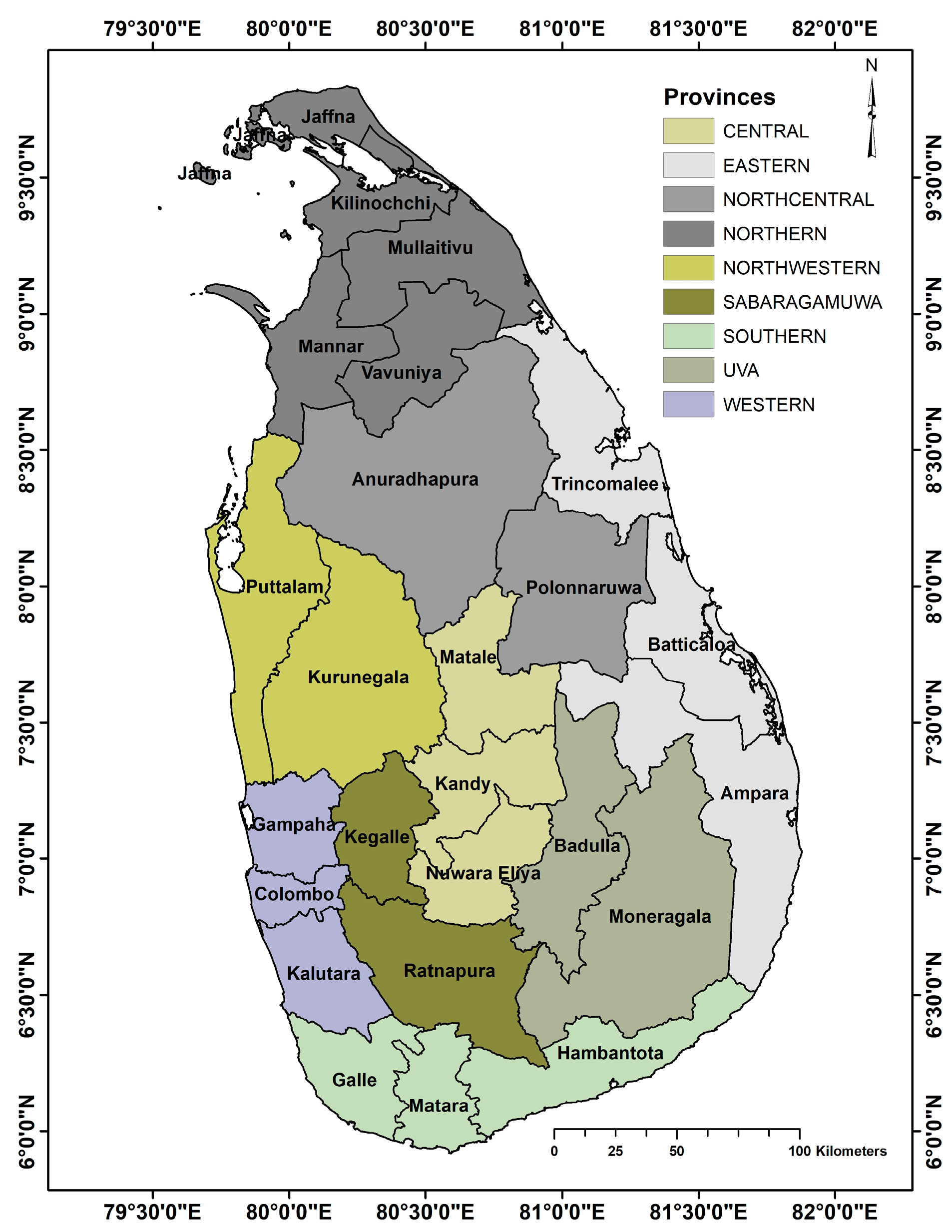
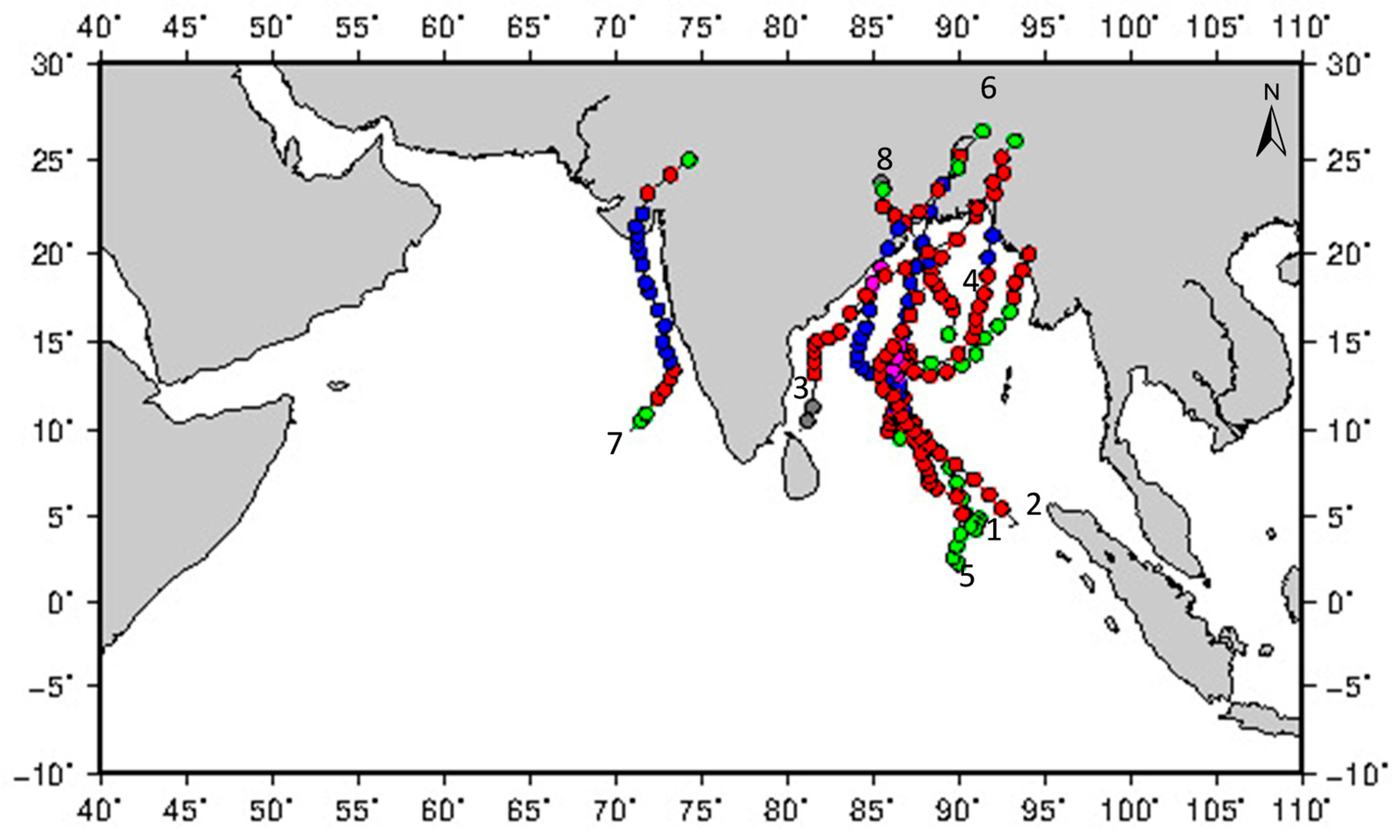
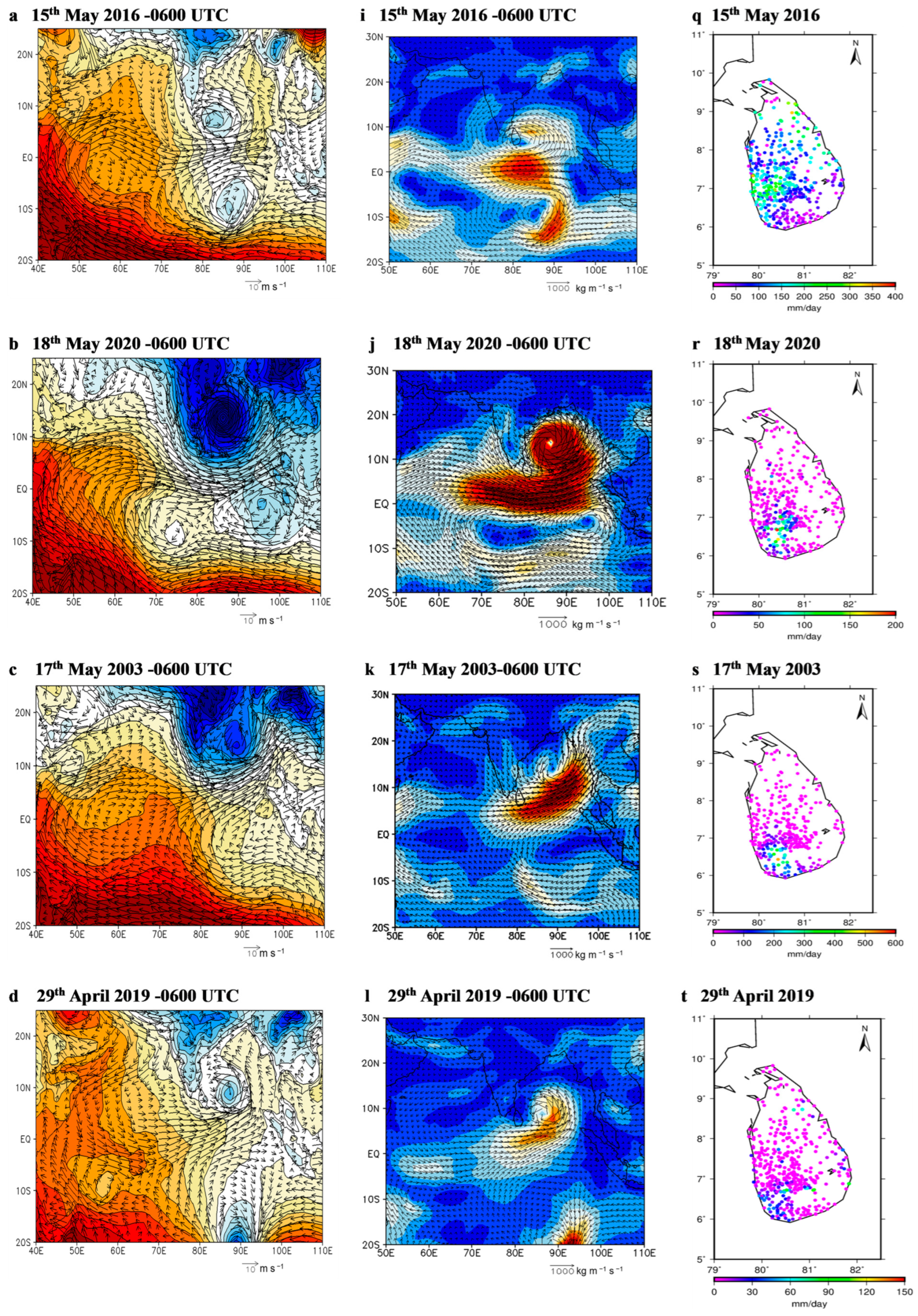
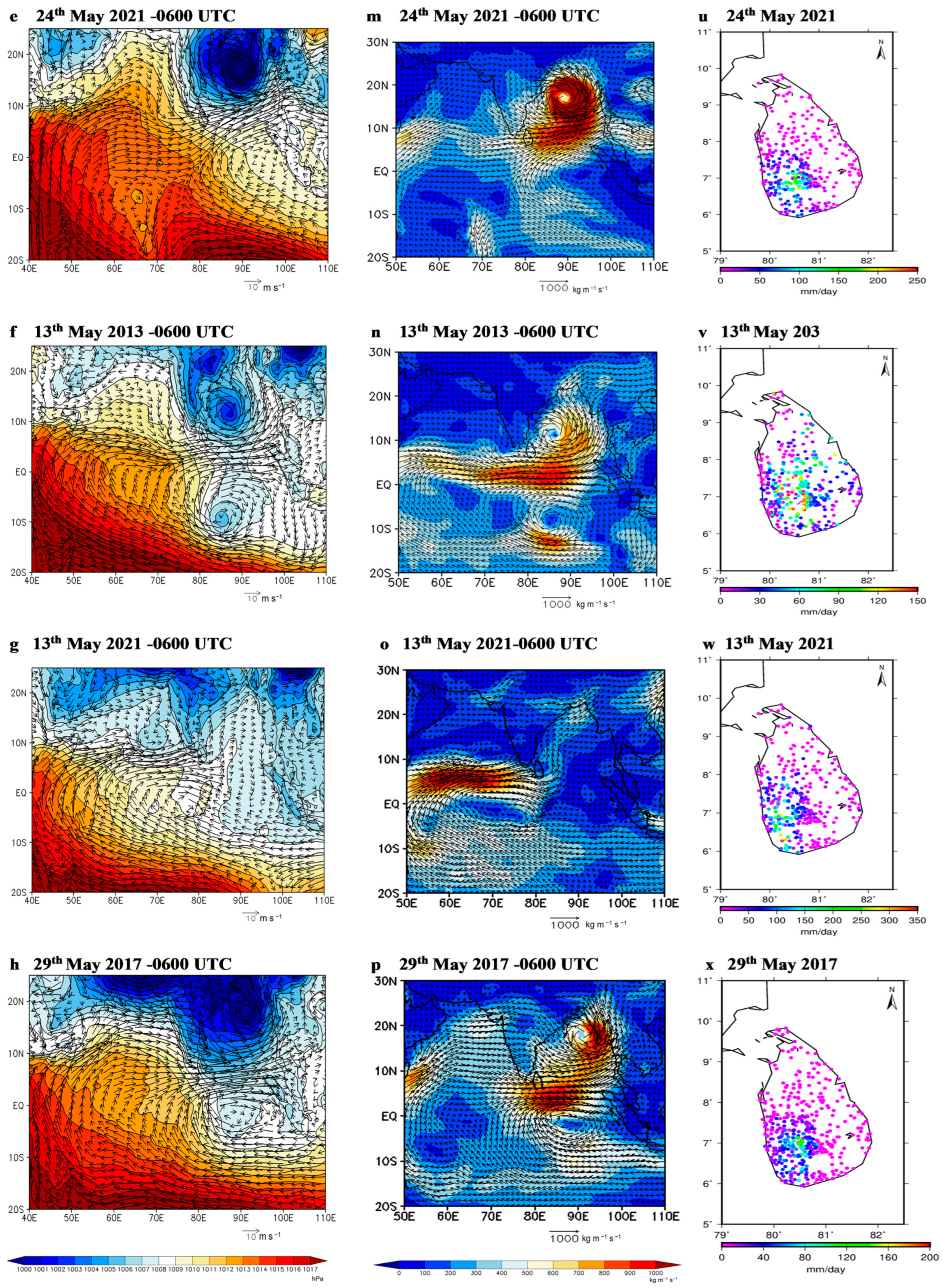
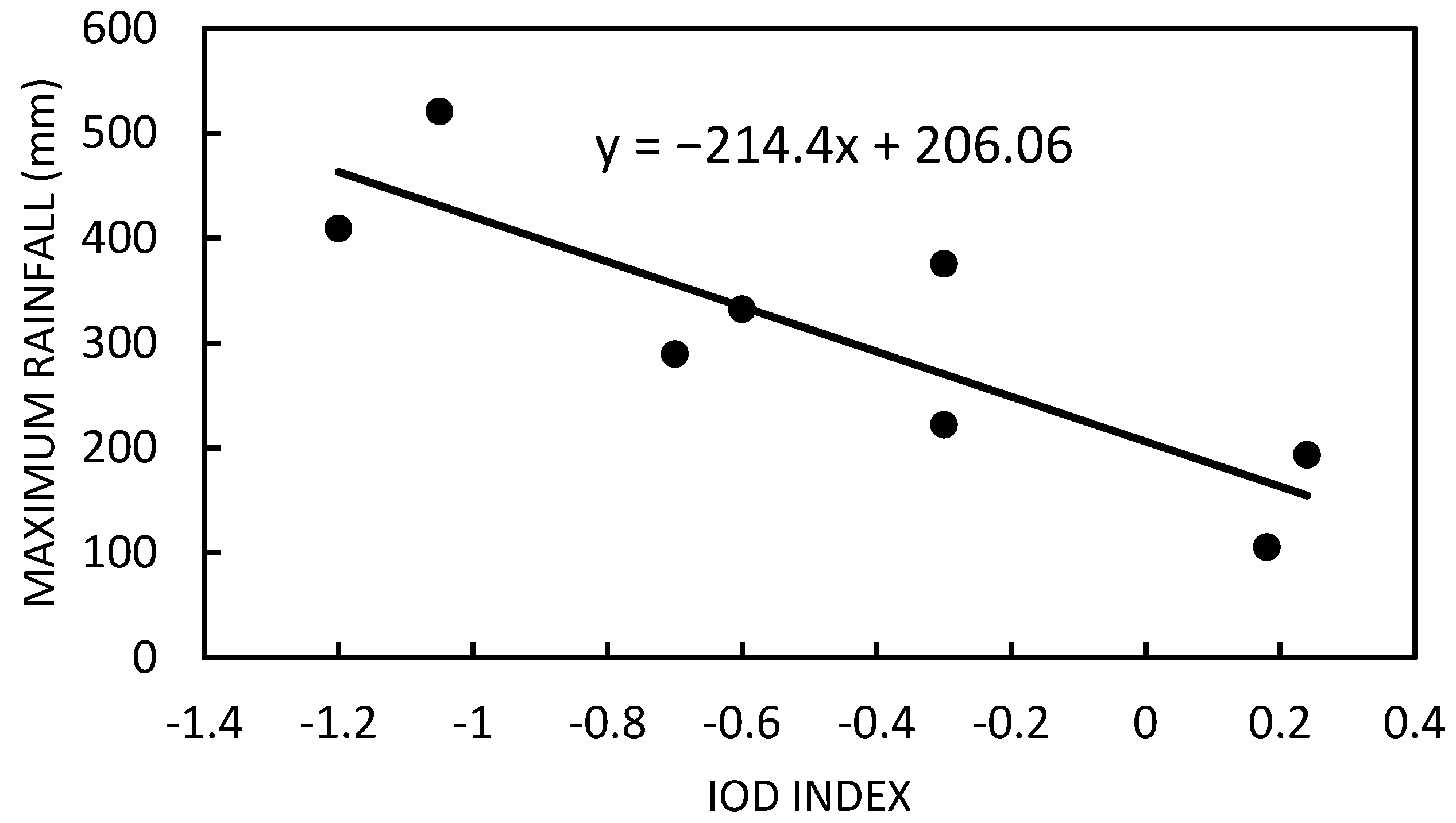
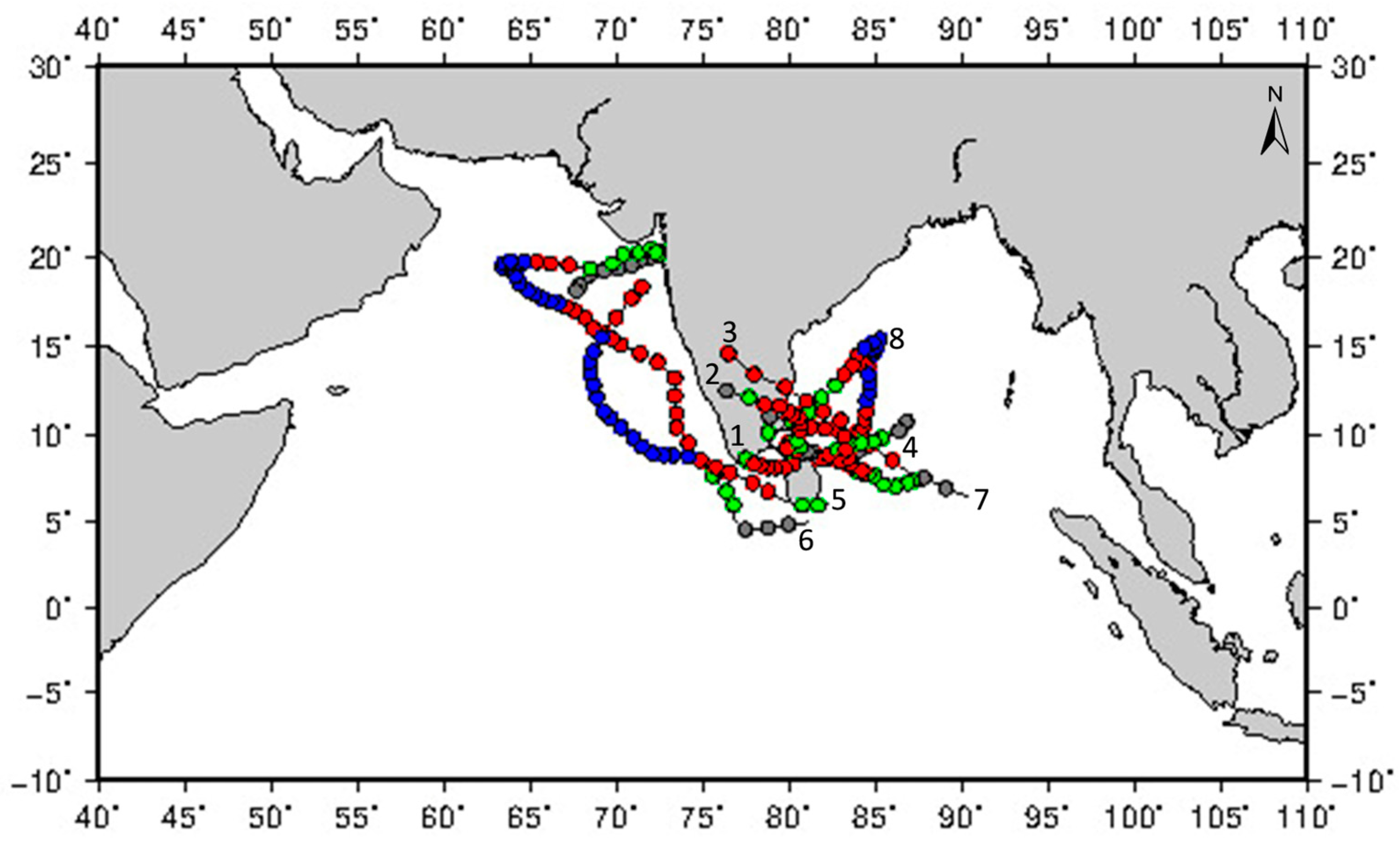
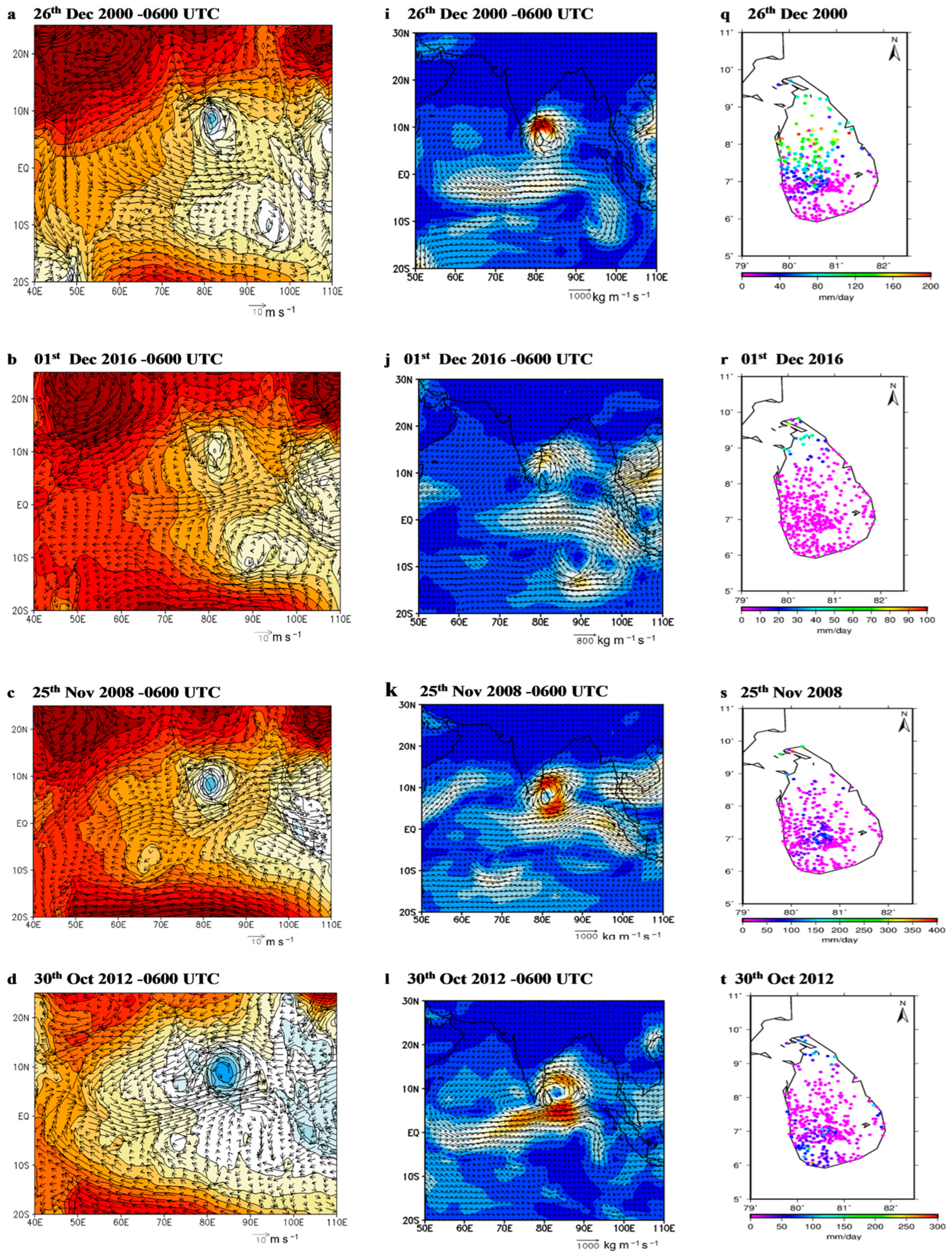


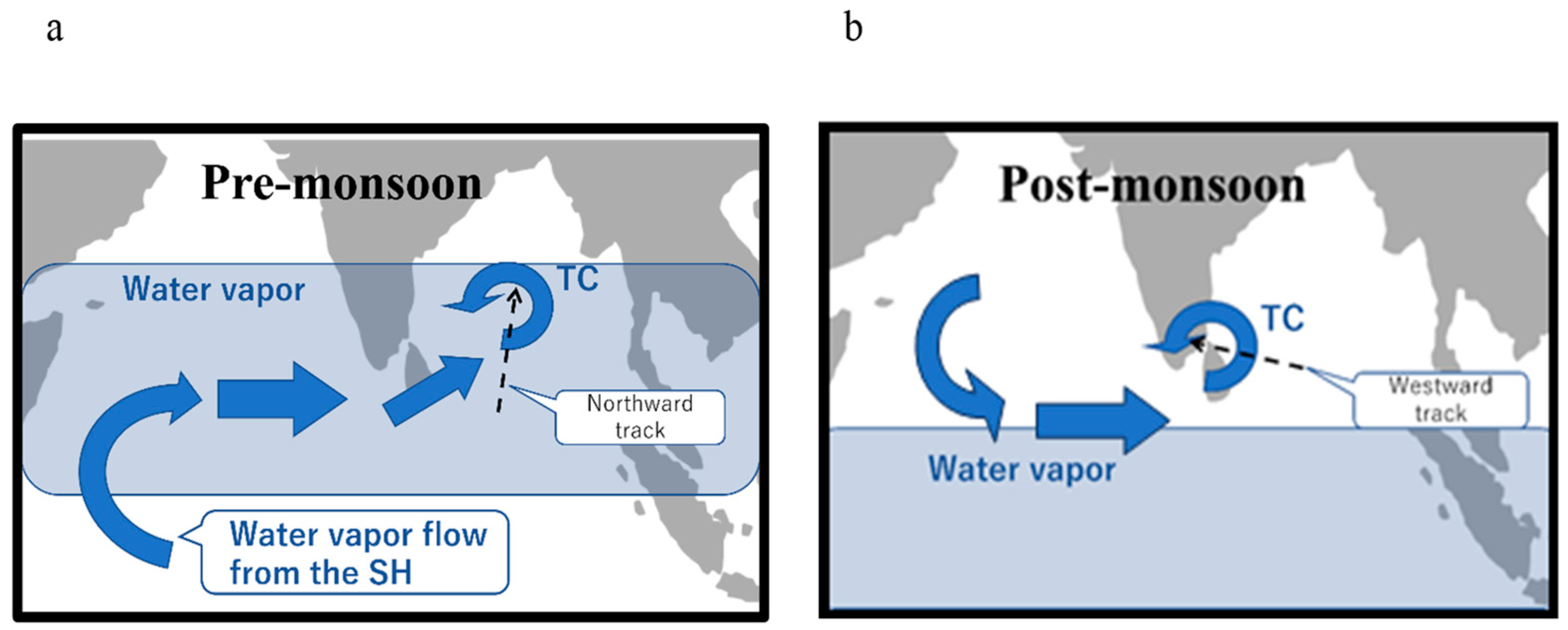
| TC Name | Year and IOD Phase | Duration | Minimum Sea Level Pressure (hPa) | Maximum Wind Speed (km/h) | Damage |
|---|---|---|---|---|---|
| BOB 01 | 2003 Neutral | 10 May 2003– 20 May 2003 | 980 | 140 | 254 deaths, 24,750 houses damaged, 800,000 people affected |
| Mora | 2017 Positive | 28 May 2017– 31 May 2017 | 978 | 110 | 203 deaths, 96 missing; affected 588,082 in 153,303 families |
| Viyaru | 2013 Negative | 10 May 2013– 17 May 2013 | 990 | 85 | 16 deaths |
| Roanu | 2016 Negative | 15 May 2016– 22 May 2016 | 983 | 85 | 204 deaths displaced over 134,000 |
| Amphan | 2020 Negative | 16 May 2020– 21 May 2020 | 920 | 240 | 5 deaths; it affected 2,000 people; over 500 houses were damaged |
| Tauktae | 2021 Negative | 14 May 2021– 19 May 2021 | 950 | 185 | 5 deaths; 48,300 people (12,177 families) affected |
| Yaas | 2021 Negative | 23 May 2021– 28 May 2021 | 974 | 120 | 4 deaths; it affected 42,000 people; over 200 houses were damaged |
| Fani | 2019 Positive | 26 April 2019– 4 May 2019 | 932 | 215 | 3 deaths; affected 5885 people in 1515 families; over 1137 houses were damaged |
| TC Name | Year and IOD Phase | Duration | Minimum Sea Level Pressure (hPa) | Maximum Wind Speed (km/h) | Damage |
|---|---|---|---|---|---|
| BOB 06 | 2000 Neutral | 23 December 2000–28 December 2000 | 970 | 165 | 9 deaths; 500,000 people were affected; damaged 480 houses and wrecked 95 fishing boats |
| Ockhi | 2017 Positive | 28 November 2017–5 December 2017 | 976 | 155 | 13 deaths; displaced 200,000 |
| Nada | 2016 Negative | 29 November 2016–2 December 2016 | 1000 | 75 | 12 deaths |
| Burevi | 2020 Negative | 29 November 2020–5 December 2020 | 996 | 85 | 6 deaths; 3586 houses were damaged and a total of 95,734 persons were affected |
| Madi | 2013 Negative | 5 December 2013–12 December 2013 | 986 | 120 | 5 deaths |
| Nisha | 2008 Neutral | 24 November 2008–29 November 2008 | 996 | 85 | 15 deaths; displaced about 90,000 people |
| Nilam | 2012 Positive | 27 October 2012–11 November 2012 | 987 | 85 | 10 deaths; 4627 people were displaced |
| Maha | 2019 Positive | 28 October 2019–11 November 2019 | 956 | 185 | 1 death; 771 houses were damaged and 20,976 people were affected in 5427 families |
| Positive IOD years | 2006, 2007, 2012, 2015, 2017, 2018, 2019 |
| Negative IOD years | 2005, 2010,2013, 2016, 2020, 2021, 2022 |
| Neutral IOD years | 2000, 2001, 2002, 2003, 2004, 2008, 2009, 2011, 2014 |
| Date | IOD Index | Max. Rainfall |
|---|---|---|
| 17 May 2003 | −1.05 | 521 |
| 13 May 2013 | −1.20 | 409.1 |
| 15 May 2016 | −0.30 | 375.6 |
| 24 May 2021 | -0.60 | 332.2 |
| 13 May 2021 | −0.30 | 222 |
| 18 May 2020 | 0.24 | 193.3 |
| 29 May 2017 | −0.70 | 289.5 |
| 29 April 2019 | 0.18 | 105.5 |
| Correlation Coefficient | −0.84 | |
| Date | IOD Index | Max. Rainfall |
|---|---|---|
| 02 December 2020 | −0.87 | 392 |
| 25 November 2008 | −0.94 | 389.8 |
| 12 December 2013 | −0.47 | 108.8 |
| 29 November 2017 | −0.95 | 289.5 |
| 26 December 2000 | −1 | 285 |
| 30 October 2012 | −0.03 | 264.5 |
| 28 October 2019 | 2.74 | 137.2 |
| 01 December 2016 | −1.76 | 74.9 |
| Correlation Coefficient | −0.24 | |
Disclaimer/Publisher’s Note: The statements, opinions and data contained in all publications are solely those of the individual author(s) and contributor(s) and not of MDPI and/or the editor(s). MDPI and/or the editor(s) disclaim responsibility for any injury to people or property resulting from any ideas, methods, instructions or products referred to in the content. |
© 2024 by the authors. Licensee MDPI, Basel, Switzerland. This article is an open access article distributed under the terms and conditions of the Creative Commons Attribution (CC BY) license (https://creativecommons.org/licenses/by/4.0/).
Share and Cite
Jayasekara, S.; Ushiyama, T.; Rasmy, M.; Kamae, Y. Investigation of Tropical Cyclones in the North Indian Ocean and the Linkage to Extreme Weather Events over Sri Lanka. Atmosphere 2024, 15, 390. https://doi.org/10.3390/atmos15040390
Jayasekara S, Ushiyama T, Rasmy M, Kamae Y. Investigation of Tropical Cyclones in the North Indian Ocean and the Linkage to Extreme Weather Events over Sri Lanka. Atmosphere. 2024; 15(4):390. https://doi.org/10.3390/atmos15040390
Chicago/Turabian StyleJayasekara, Sachintha, Tomoki Ushiyama, Mohamed Rasmy, and Youichi Kamae. 2024. "Investigation of Tropical Cyclones in the North Indian Ocean and the Linkage to Extreme Weather Events over Sri Lanka" Atmosphere 15, no. 4: 390. https://doi.org/10.3390/atmos15040390
APA StyleJayasekara, S., Ushiyama, T., Rasmy, M., & Kamae, Y. (2024). Investigation of Tropical Cyclones in the North Indian Ocean and the Linkage to Extreme Weather Events over Sri Lanka. Atmosphere, 15(4), 390. https://doi.org/10.3390/atmos15040390







